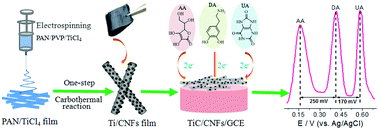当前位置:
X-MOL 学术
›
J. Mater. Chem. B
›
论文详情
Our official English website, www.x-mol.net, welcomes your
feedback! (Note: you will need to create a separate account there.)
Flexible and conductive titanium carbide–carbon nanofibers for the simultaneous determination of ascorbic acid, dopamine and uric acid†
Journal of Materials Chemistry B ( IF 6.1 ) Pub Date : 2018-06-22 00:00:00 , DOI: 10.1039/c8tb00938d Qiaohui Guo 1, 2, 3, 4 , Tingting Wu 1, 2, 3, 4 , Lijuan Liu 1, 2, 3, 4 , Haoqing Hou 1, 2, 3, 4 , Shuiliang Chen 1, 2, 3, 4 , Li Wang 1, 2, 3, 4
Journal of Materials Chemistry B ( IF 6.1 ) Pub Date : 2018-06-22 00:00:00 , DOI: 10.1039/c8tb00938d Qiaohui Guo 1, 2, 3, 4 , Tingting Wu 1, 2, 3, 4 , Lijuan Liu 1, 2, 3, 4 , Haoqing Hou 1, 2, 3, 4 , Shuiliang Chen 1, 2, 3, 4 , Li Wang 1, 2, 3, 4
Affiliation

|
The development of novel materials for facile, cost-effective and quick practical application is a demanding research interest in electroanalytical chemistry. Titanium carbide (TiC), as one of the most important transition metal carbides, exhibits good chemical stability and electrical conductivity, and its electrocatalytic activity resembles that of metals, but is much cheaper. In this work, TiC nanoparticle (NP) loaded carbon nanofiber (CNF) films (TCNFs) are synthesized using an electrospinning and carbothermal technique, which facilely maintains their structural integrity with robust adhesion. Uniform TiC NPs are firmly embedded in the surface of CNFs, which integrates the large surface area and unique 3D, porous network structure of CNFs with the good conductivity and excellent electrocatalytic activity of TiC NPs. Simultaneous electrochemical sensing of ascorbic acid (AA), dopamine (DA) and uric acid (UA) at TCNFs displays excellent peak current signals with well-defined peak potentials. The linear ranges are 0.001–1.5 mM, 0.05–160 μM and 0.001–0.875 mM for AA, DA and UA, and the corresponding detection limits are 0.3 μM, 20 nM and 0.3 μM, respectively. In addition, TCNFs show long-term sensing stability and potential applications in real samples, and behave as good anti-interference agents towards KNO3, ZnSO4, glucose, etc. Most importantly, unlike some common carbon-based electrochemical sensor systems, an adsorption-less response is observed for the test analytes at the TCNF electrode. TCNFs show interesting potential as candidates for the construction of electrochemical sensors.
中文翻译:

柔性且导电的碳化钛-碳纳米纤维,可同时测定抗坏血酸,多巴胺和尿酸†
在电分析化学领域中,对用于简便,经济高效且快速实用的新型材料的开发提出了苛刻的研究兴趣。碳化钛(TiC)作为最重要的过渡金属碳化物之一,具有良好的化学稳定性和导电性,其电催化活性与金属相似,但价格便宜得多。在这项工作中,使用静电纺丝和碳热技术合成了负载有TiC纳米颗粒(NP)的碳纳米纤维(CNNF)薄膜(TCNF),该技术可通过牢固的粘附力轻松保持其结构完整性。均匀的TiC NPs牢固地嵌入CNFs的表面中,它集成了CNFs的大表面积和独特的3D多孔网络结构,具有良好的电导率和TiC NPs的出色电催化活性。在TCNF处同时对抗坏血酸(AA),多巴胺(DA)和尿酸(UA)进行电化学检测,可显示出色的峰值电流信号,并具有明确的峰值电势。AA,DA和UA的线性范围分别为0.001–1.5 mM,0.05–160μM和0.001–0.875 mM,相应的检出限分别为0.3μM,20 nM和0.3μM。此外,TCNF在真实样品中显示出长期的传感稳定性和潜在应用,并且对KNO表现出良好的抗干扰作用3,ZnSO 4,葡萄糖等。最重要的是,与某些常见的基于碳的电化学传感器系统不同,在TCNF电极上观察到测试分析物的无吸附响应。TCNF具有令人感兴趣的潜力,可作为构建电化学传感器的候选材料。
更新日期:2018-06-22
中文翻译:

柔性且导电的碳化钛-碳纳米纤维,可同时测定抗坏血酸,多巴胺和尿酸†
在电分析化学领域中,对用于简便,经济高效且快速实用的新型材料的开发提出了苛刻的研究兴趣。碳化钛(TiC)作为最重要的过渡金属碳化物之一,具有良好的化学稳定性和导电性,其电催化活性与金属相似,但价格便宜得多。在这项工作中,使用静电纺丝和碳热技术合成了负载有TiC纳米颗粒(NP)的碳纳米纤维(CNNF)薄膜(TCNF),该技术可通过牢固的粘附力轻松保持其结构完整性。均匀的TiC NPs牢固地嵌入CNFs的表面中,它集成了CNFs的大表面积和独特的3D多孔网络结构,具有良好的电导率和TiC NPs的出色电催化活性。在TCNF处同时对抗坏血酸(AA),多巴胺(DA)和尿酸(UA)进行电化学检测,可显示出色的峰值电流信号,并具有明确的峰值电势。AA,DA和UA的线性范围分别为0.001–1.5 mM,0.05–160μM和0.001–0.875 mM,相应的检出限分别为0.3μM,20 nM和0.3μM。此外,TCNF在真实样品中显示出长期的传感稳定性和潜在应用,并且对KNO表现出良好的抗干扰作用3,ZnSO 4,葡萄糖等。最重要的是,与某些常见的基于碳的电化学传感器系统不同,在TCNF电极上观察到测试分析物的无吸附响应。TCNF具有令人感兴趣的潜力,可作为构建电化学传感器的候选材料。











































 京公网安备 11010802027423号
京公网安备 11010802027423号